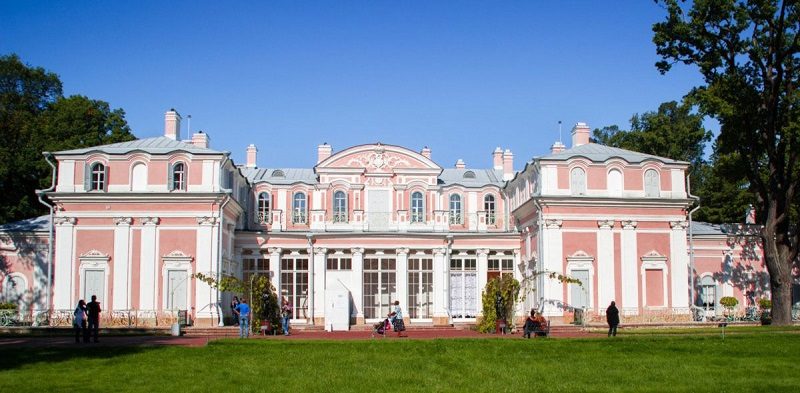Chinese Palace in Oranienbaum, St Petersburg
Address: St. Petersburg, Lomonosov, Dvortsovy pr., 46

Description
The palace in Oranienbaum is so named because of the interior decoration of the halls - luxurious Chinese ornaments adorn the walls of the palace. Once there was celebrated the triumph of the Russian army in the battles with the Turks, and now conduct tours and talk about the emperors and queens.
Rinaldi built the country residence for Catherine II in 1760-1768. Until that time, the Chinese house/Kitaysky Dom was already in Oranienbaum, only it was made of wood and was located near the fortress Petershtadt on the bank of the Karasta river. The building was built in the rococo style, which (unlike the more magnificent and pompous baroque) is characterized by refinement, sophistication and delicate taste. The Chinese palace/Kitaysky Dvorets was not created for official receptions, but for recreation and entertainment of Catherine II and those close to her.
The western part of the palace completely belonged to the tsarina, the eastern part - to her son Pavel Petrovich, who by the end of construction had passed 14 years.
In total, there are 17 halls in the Chinese palace; they danced in them, played cards and organized feasts. Moreover, each room was decorated in a peculiar way and differed from all the others. Gilding and mirrors, stucco and painting were used as decorations.
The Front Suite/Paradnaya Anfilada (the main axis of the building) includes the Hall of the Muses/Zal Muz, the Blue Living Room/Golubaya Gostinnaya and the Glasshouse study/Steklyarusny Kabinet, the Great Hall/Bolshoy Zal and the Lilac Living Room/Sirenevaya Gostinnaya, the Maly and the Bolshoy Kitaysky Study.
It was within this palace that the empress and her entourage celebrated the outcome of the Russian-Turkish war, although in the 34 years of her reign Catherine II had spent only 2 months at her own summer cottage.
Such neglect, of course, was undeserved. The luxury of the palace causes dizziness: an abundance of decorative painting adorning the walls, floors made of precious wood, gilded stucco, marble, bas-reliefs, wall paintings, could not but shake the imagination. To add to everything listed a pond, to which a picturesque staircase led, sculptures on ancient Greek themes and the famous Glasshouse room - and this turned out to be a true paradise. To decorate the halls in the oriental style, many art objects were delivered from China and Japan. The palace houses art objects from the 18th century - paintings and porcelain collections brought from the east and from Europe, carved and gilded furniture created by Russian carvers and gilders according to Rinaldi's drawings.
Particularly noteworthy is the parquet, featuring a variety of patterns and colors. Originally the floor in the rooms was made of marble, and in 1770 it was replaced by a type-setting parquet, which was created using more than 20 species of trees, among them red, black and brown wood, as well as boxwood, amaranth and Persian walnut.
Halls of the Kitaysky Palace
In 1850, the entrance to the building was moved to the east side, where Bolshaya Antikamera was attached, which served as the Antechamber. Excursion to the Kitaysky Palace begins with this room, a kind of hallway. A monitor is installed here and while the group is gathering, you can watch a film about the history of the palace, Cast-iron floor lamps made in the 19th century in Paris were installed at the door leading to the next Zal Muz, and earlier they stood on the porch at the entrance to Antikamera.
Hall of Muses/Zal Muz
The Antikamera is followed by the Zal Muz, which is often called the Picturesque Gallery. Its walls are decorated with paintings by Italian painter Stefano Torelli, depicting Apollo with cupids and nine muses, personifying art. On the ceiling you can see the goddess of beauty and love Venus and her companions graces.
Bugle cabinet/Steklyarusny Kabinet
The decor of the Steklyarusny Kabinet is the most original. The hall is decorated with twelve panels embroidered with glass beads (long tubular beads). On the basis of glass fiber embroidery is made with fleece threads depicting exotic plants and birds against the backdrop of fabulous landscapes. Each panel is separated from the neighboring carved gilded frame. There are no analogues of the Steklyarusny Kabinet in the world.
Blue living room/Golubaya Gostinnaya
Initially, the walls of this room were decorated with blue silk, so the living room is called blue. Later, the dilapidated material was removed, and on the walls were placed canvases by the Petersburg artist Alexander Beideman, created in 1862-1868.
Pink living room/Rozovaya Gostinnaya
The ceiling of the Rozovaya Gostinnaya with the image of Diana is painted by the Venetian painter Gasparo Dizziani. The decoration of the living room are also two picturesque panels depicting cupids. Previously, the room was decorated with ceremonial and chamber portraits of Catherine II. According to legend, in this room often played a little Paul, the son of the empress.
Wardrobe/Garderobnaya
In former times, the Garderobnaya was decorated with elegant furniture and paintings. Now you can see only a fireplace and pale blue walls decorated with carvings and stucco.
Great hall/Bolshoy Zal
The Bolshoy Hall is the main room of the Kitaysky Palace, it was also called the Reception and Oval Hall (the room has the shape of an ellipse). The hall is located in the center of the main ceremonial enfilade. The large hall served to receive guests and therefore its design is distinguished by rigor and solemnity. The height of the room is 8.5 meters, in its decoration used artificial marble of various colors and paintings, stucco and mosaic. The presence of columns makes the interior somewhat classic.
Front/Perednyaya
The Perednyaya originally served as a vestibule; guests entered it from the central entrance. Their admiration was caused by everything around - the parquet floor resembling a carpet, the walls painted by Stefano Torelli and the picturesque ceiling “Apollo and the arts” (attributed by Serafino Barozzi and Stefano Torelli)
In the middle of the XIX century, the palace passed into the possession of the Grand Duchess Catherine Mikhailovna, becoming a gift to the wedding with the Duke Georg Mecklenburg-Strelitzky. Under her order, architect Ludwig Bonstedt made minor changes - he built the second attic floor on the south side of the palace and created a glass-enclosed lobby-gallery.
In 1922, the palace was turned into a museum, and during the war years, the Kitaysky palace was partially damaged as a result of the blockade, artillery attacks and bombings, although there was no military action on the territory of Oranienbaum. In the years that followed the war, restoration work was carried out in Lomonosov, and by 1949, visitors had the opportunity to inspect the palace entirely.
At present, restoration work is underway inside the palace - seven of them were restored from seventeen halls.
Read more
- How to travel in Saint Petersburg without living your home
- Four of the ten best restaurants in the country are in St. Petersburg
- The first Holocaust museum in St. Petersburg
- A scientist from St. Petersburg created the biochronicle of Peter the Great.
- 10 interesting facts about Saint-Petersburg streets

Moderate 2 Day
Shore Excursion
St. Petersburg, Russia
from 241$